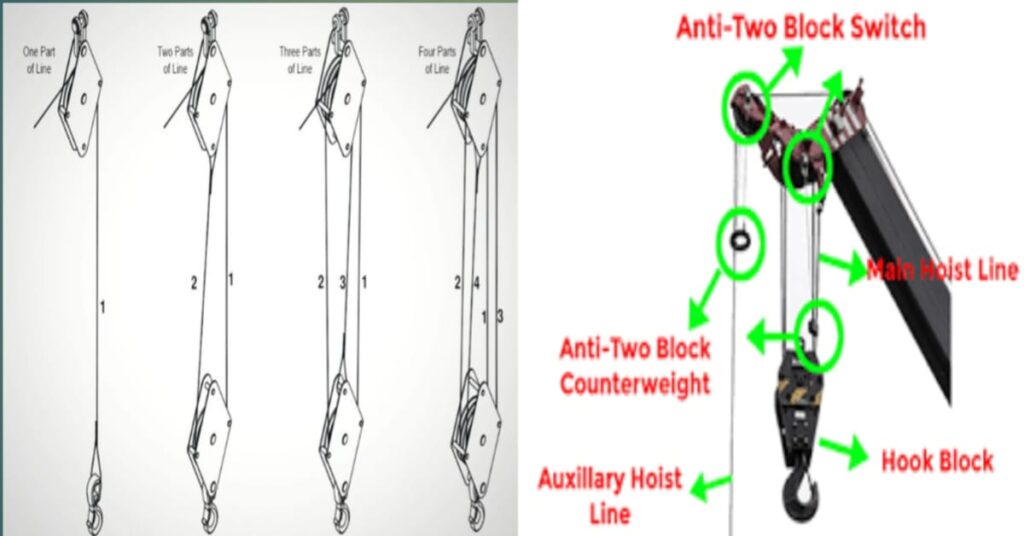Identification: The number of wire rope lines or branches that encircle the hook block is referred to as the “Crane Parts Line.” During lifting operations, this technique is used to distribute loads securely and effectively.
Types of hook parts.
- Auxiliary Hook Block:
a) Function: Usually employed for little load lifting.
b) Design: Typically includes a single hook portion (single part line).
c) Speed: Because the loads are light, this kind does not need to be divided into multiple portions, allowing for a higher lifting speed. - Main Hook Block:
a) Function: Usually used to lift heavy loads.
b) Design: It has several elements that work together to better distribute the weight.
c) Speed: Because the load must be divided over multiple components to ensure adequate strength to raise large weights, the lifting speed is slower. The impact of component count on performance Quickness: The lifting speed falls off as the number of hook segments rises. This is because the system needs more power to spread the load over more wire ropes, which means that speed must be lowered to maintain efficiency and safety.
Capacity: Lifting large loads is made possible by adding more hook sections. Greater weights can be lifted since the weight is divided over several components, which lessens the strain on each wire rope. Applications of Offshore Cranes: Typical Duty Cranes Operating Offshore:
Extra block: It increases efficiency in daily lifting activities by lifting light loads faster. Main block: It is used to lift huge loads, albeit at a slower rate of lift because there is a greater requirement to disperse the load for efficiency and safety. Design significance Safety: The hook system is made to distribute loads safely and guard against failure or breakage. Efficiency: Whether in terms of speed for light loads or capacity for huge loads, the design of the hook sections helps to achieve the necessary efficiency in lifting activities.

A-Summary
The design and operation of cranes depend heavily on an understanding of the distribution of hook pieces and how that distribution affects lifting capacity and speed.
While using a main hook block offers sufficient capacity to raise huge loads safely and efficiently, using an extra hook block allows for faster lifting speeds for lighter weights. Lifting activities become safer and more efficient when speed and power are balanced through proper system design.
Bringing Safety to Life via Cooperation: Tower Crane Collapse Lifting Engineers and Civil Engineers Unite!
What could be the cause of this occurrence? Below, please comment: The tower crane collapses, posing a threat to life and impeding further advancement. This situation emphasizes how crucial it is for lifting engineers and civil engineers to work together during the planning process.
5 Strategies to Solve the Issue: Early Engagement: To guarantee that lifting considerations are incorporated into the structural design, involve civil engineers and lifting engineers from the project’s outset. This stage of collaboration avoids costly rework and last-minute alterations.
1) Shared Expertise: Combine the structural knowledge of civil engineers with the special lifting engineers have in rigging, hoisting, and crane operations. They can anticipate difficulties, evaluate hazards, and come up with solutions for safe lifting operations when they work together.
2) Clear Communication: Encourage open lines of communication to facilitate information sharing, activity coordination, and problem solving between lifting and civil engineering teams. Consistency and clarity in project requirements are fostered by regular meetings and consultations.
3) Risk Assessment: To find possible risks connected to lifting activities, carry out in-depth risk assessments. To reduce hazards and guarantee worker safety, create mitigation techniques, backup plans, and emergency procedures cooperatively.
4) Continuous Improvement: Develop a culture of continuous improvement by using lessons discovered in the past and drawing lessons from them. Promote feedback, exchange optimal techniques, and allocate resources for continuous training to augment cooperation and safety results.
5) Relevant Statistics: Industry data indicates that a 50% reduction in workplace accidents can be achieved by coordination in planning between lifting engineers and civil engineers. Furthermore, safety-focused collaborative initiatives saw a 20% drop in project costs and a 30% boost in productivity.
Now, I would really like to hear from you: In your projects, how do you encourage cooperation between lifting engineers and civil engineers? Leave your thoughts in the space provided below, and let us keep working to create a safer future!